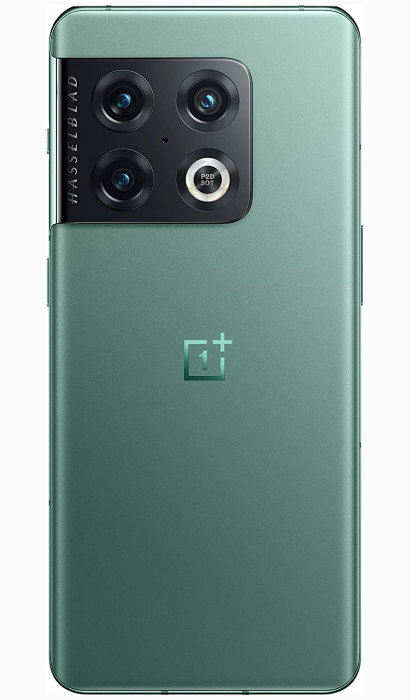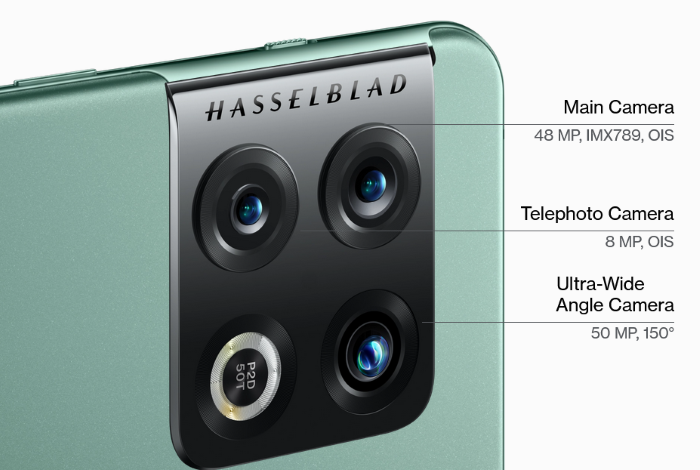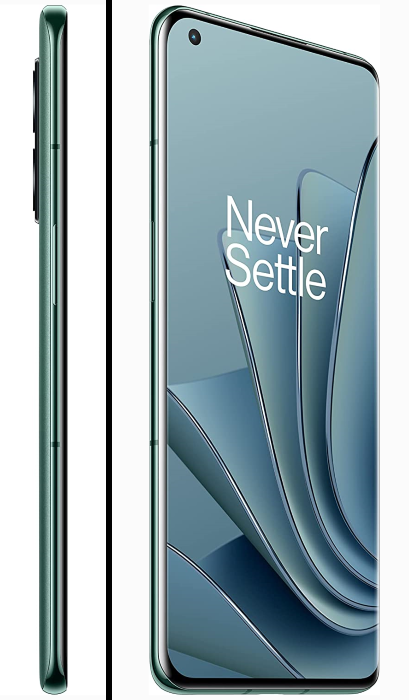Nowadays, more and more people consider getting a high-end 5G Smartphone, as most Smartphone manufacturers currently focus on releasing better flagship 5G Smartphones that are specifically designed with top-tier specs in order to ultimately deliver an outstanding performance for the best possible user experience. When purchasing a high-end 5G Smartphone, you can expect to get a Smartphone that not only features a nearly flawless build-quality, but also a high-quality display screen with great pixel density, highly-adjustable brightness settings, and also a high refresh rate, as well as high-end camera systems on both of its front- and back-sides, and even a long-lasting battery life that can last you over a day. So, if you’re thinking about upgrading from your current phone and to a high-end 5G Smartphone, then consider checking out the OnePlus 10 Pro 5G Smartphone.
The OnePlus 10 Pro is a 5G Smartphone that features a 6.7″ QHD+ 120 Hz Fluid AMOLED Display powered by LTPO 2.0 Refresh Rate Calibration technology, a powerful next-gen X-axis linear haptic motor that delivers a more immersive haptic vibration feedback, plus a Second-Generation Hasselblad Triple Camera System that combines a 48 MP Main Camera with a 8 MP Telephoto Camera and a 50 MP Ultra-Wide Angle Camera, along with a 32 MP Front Camera, either 128GB, 256GB, or 512GB of Storage along with 8GB or 12GB RAM, as well as both Bluetooth 5.2, GPS, and 5G Connectivity, and also a Li-Po 5000 mAh battery that can offer you approximately from 13 hours up to a maximum of 33 hours of battery life.
In comparison to most 5G Smartphones that are currently available on the market, OnePlus 10 Pro is guaranteed to rank as one of the best 5G Smartphones in pretty much every aspect and/or criteria, from its display screen, to its cameras, interface, connectivity options, and even its battery life.
Now, let’s have a more detailed look at it and talk a little more about everything that this 5G Smartphone has to offer you.
DESIGN & SPECS
Starting with the phone’s size, while the OnePlus 10 Pro comes at a slightly bigger size than some of the most modern Smartphones, this 5G Smartphone is still impressively slim, with it measuring exactly 6.41 inches long by 2.90 inches wide by 0.33 inches tall / thick (163 x 73.9 x 8.55 mm).

In addition to its slim size, the phone is also quite lightweight, weighing just 7.07 oz. (200.5 g).
In terms of its design, the OnePlus 10 Pro also features a sleek design throughout its ultra-slim body, meaning that you can easily fit it inside pretty much any pocket, all while also packing a stylish and ultra-modern look.

Not only that, but this 5G Smartphone also features a fairly durable construction, as its main body is composed by a high-quality aluminum frame.

Furthermore, the phone’s front-side also features a high-grade glass front-cover built from Corning Gorilla Glass Victus that’s fairly tough, all while it’s back-side also features a high-grade glass back-cover that’s just as tough, as it is built from Corning Gorilla Glass 5. Essentially, the OnePlus 10 Pro’s front-side and back-side glass covers make this 5G Smartphone fairly scratch-resistant, as well as fingerprint-resistant (which for the latter, is something that its predecessor couldn’t offer).
We’d also like to note that the phone’s back-side also integrates a 3D nano-microcrystalline ceramic camera cover that’s built on top of its Second-Generation Hasselblad Triple Camera System (integrated at its back-side) which is in fact rated to have an impressive hardness-rating of 8.5Mohs, as its 3D nano-microcrystalline ceramic camera cover is built by being heated at 1400ºC for a total of 96 hours. The phone’s 3D nano-microcrystalline ceramic camera cover is then meticulously polished for over 60 hours for a premium finish.

In comparison to the typical stainless steel camera covers that many flagship 5G Smartphones currently come with, the OnePlus 10 Pro’s 3D nano-microcrystalline ceramic camera cover is rated to have a 30% higher wear-resistance.
Moving on to the Smartphone’s different components. Starting with the phone’s display screen, the OnePlus 10 Pro comes equipped with a 6.7″ QHD+ Fluid AMOLED Display Screen that boasts a 1440p resolution (3216 x 1440 pixels) with a 525 ppi density and a 20.1:9 Aspect Ratio.

Now, in terms of the phone’s screen Refresh Rate, it’s worth noting that its 6.7″ QHD+ Fluid AMOLED Display Screen is actually powered by LTPO 2.0 Refresh Rate Calibration technology, which allows its screen to dynamically scale and adjust its Refresh Rate from 1Hz up to 120Hz, ultimately allowing the phone to delivering a fluid user experience with an optimized battery performance.
Note that the 6.7″ QHD+ Fluid AMOLED Display Screen features support to 1 Hz AOD (meaning that its display screen can automatically scale-down its refresh rate to as low as 1Hz in order to save power), Next-gen AI Adaptive Brightness for dynamic brightness adjustments, as well as support to Dual Color Calibration for delivering a class-leading color accuracy in any brightness setting, and even Super-Resolution Enhancements that are used for improving the standard quality of images and videos by up to four (x4) times.
Moreover, not only does the phone’s 6.7″ QHD+ Fluid AMOLED Display Screen feature support to sRGB (which an industry standard RGB color-space model use for measuring Color Space in order to represent a spectrum of colors), but also support to Display P3 (which is a next-generation RGB color-space model that ultimately allows the phone’s 6.7″ QHD+ Fluid AMOLED Display Screen to represents an extra 25% larger spectrum of colors when compared to the current industry standard sRGB color-space model).
In addition, the phone’s 6.7″ QHD+ Fluid AMOLED Display Screen also features support to HDR10+, which ultimately ensures users can get a higher quality and much more clarity when looking at an image or a video that’s playing on the phone’s screen, as well as support to 10-bit Color Depth, which is used for displaying the best possible color representations, especially when viewing high-quality photos and videos.
Finally, for the phone’s remaining Hardware Specs, while our review unit of the OnePlus 10 Pro featured 128GB of Storage Capacity and 8GB of LPDDR5 RAM, know that you can also get this 5G Smartphone in different models that have higher specifications, including a model with 256GB Storage and 8GB RAM (LPDDR5), a model with 256GB and 12GB RAM (LPDDR5), or ultimately, the highest-end model, which packs 512GB Storage and 12GB RAM (LPDDR5).
Sadly, the phone’s Storage Capacity is not expandable via the use of a Micro-SD Card (meaning there’s no External Memory option), as this 5G Smartphone doesn’t come with a dedicated Micro-SD Card Slot for that.
Still in terms of its storage specifications, it’s also worth pointing out that this 5G Smartphone utilizes UFS (Universal Flash Storage) 3.1 2-Lane Storage System (which was engineered to keep up with the growing demands of 5G) for storing all of its digital files (including downloaded files and snapped photos / videos), which ultimately helps to improve both the phone’s performance as well as its power efficiency.
Regarding the Smartphone’s performance, this 5G Smartphone utilizes a powerful 4 nm Qualcomm SM8450 Snapdragon 8 Gen 1 chipset, all while also boasting an Octa-core CPU (1×3.00 GHz Cortex-X2 & 3×2.50 GHz Cortex-A710 & 4×1.80 GHz Cortex-A510) as well as an Adreno 730 GPU.

Note that the phone’s chipset, CPU and GPU are all directly cooled by a 5-Layer 3D Passive Cooling System, which essentially allows for an even faster and smoother performance, meaning that users can more comfortably use more demanding Apps without having to worry about the phone’s performance starting to slow down or even freeze.
Another unique feature that’s worth mentioning is that the OnePlus 10 Pro also comes equipped with a powerful next-gen X-axis linear haptic motor that delivers cutting-edge haptic vibration feedback for a more immersive experience while users are using haptic-supported Apps (especially haptic-supported Mobile games), as well as for snapping photos / videos.

Not only that, but specifically for gaming, the OnePlus 10 Pro also comes equipped with an all-new HyperBoost gaming engine that’s triggered after users launch Mobile Games on the phone, consequently accelerating its GPU and CPU in order to unlock a higher-performance next-level gaming experience.
Finally, for its Operative System, know that the OnePlus 10 Pro comes running on OxygenOS 12.1 (based on Android 12) straight out of its box.
CAMERAS
Moving on to the phone’s two Camera setups. Starting at the back-side of the phone, we have a Second-Generation Hasselblad Triple Camera System, which combines a 48 MP Main Camera that’s powered by a customized IMX789 camera sensor (which helps to ensure an enhanced noise reduction and a higher dynamic range) together with a 8 MP Telephoto Camera and a 50 MP Ultra-Wide Angle Camera (which boasts a 150° viewing angle), along with a powerful Dual-LED dual-tone flash.

Both the phone’s 48 MP Main Camera and 8 MP Telephoto Camera boast OIS (Optical Image Stabilization) and Gyro-EIS (Electronic Image Stabilization), all while its Second-Generation Hasselblad Triple Camera System leverages both OnePlus Billion Color Solution (the company’s proprietary color-calibration system) as well as Hasselblad’s 2nd-generation Color Calibration, which allow the phone to process 64x more color information, ultimately ensuring that photos and videos come out with a stunning 10-bit coloring for richer and more dynamic color tones.

Furthermore, the phone’s Hasselblad Triple Camera System also boasts a Smart Scene Recognition functionality, a Multi Autofocus functionality (all pixel omni-directional PDAF+LAF+CAF), plus a Nightscape functionality that allows users to shoot pictures and videos with the OnePlus 10 Pro under low-light condition (i.e. at night), all while also featuring support to Ultra-HDR, as well as to Screen Flash, Panorama Mode, Portrait Mode, 150º Mode, and a few other Photo and Video Modes.
Specifically for shooting video, know that the phone’s Hasselblad Triple Camera System can shoot 8K Video at 24fps, 4K Video at 30/60/120fps, and 1080p Video at 30/60/240fps (including 1080p Super Slow Motion at 240 fps and 4K and 1080p Time-Lapse Video at 30 fps), and also 720p video at 480 fps (again including 720p Super Slow Motion).
Then, at the front-side of the phone, we have a 32 MP Punch-Hole Front Camera that comes discretely integrated at the top-left of the phone’s 6.7″ QHD+ Fluid AMOLED Display Screen. The phone’s 32 MP Front Camera also features support to Auto-HDR.

By using the phone’s 32 MP Selfie Camera, users can shoot high-definition selfie photos as well as shoot 1080p video at 30 fps.

After shooting photos and videos, users are also offered Face Unlock and Face Retouching functionalities for further improving the quality of their selfie-pictures and selfie-videos shoot with the phone’s 32 MP Front Camera.
INTERFACE
For the phone’s interface, just like most 5G Smartphones nowadays, the OnePlus 10 Pro also features a fairly simple interface.
Starting right at the very top-side of the phone, we have a built-in Microphone Array that’s features support to Noise Cancellation in order to ensure a better quality during Voice Calls.

Then, discretely centered at the top-side of the of the phone’s 6.7″ QHD+ Fluid AMOLED Display Screen, there’s an integrated Earpiece Speaker, which works as the phone’s left audio channel for its Dual Stereo Speakers, which are powered by Dolby Atmos technology.

Moving on to the right-side of the phone, we have its dedicated Power Button, and sitting directly above it, there’s also a 3-position Alert Slider Switch that can be used to conveniently toggle between Silent, Vibrate, and Ring Modes (for alarms and calls).
We’d also like to mention that the phone’s 6.7″ QHD+ Fluid AMOLED Display Screen also boasts an In-Display Fingerprint Sensor, and also supports Gesture-Controls as well as On-Screen Navigation.
Then, going to the phone’s opposite side, we have a One-Button Volume Rocker Switch integrated slightly above the middle of the phone’s left-side that can be used to conveniently control its volume-level.

Lastly, at the bottom-side of the phone, we have its Dual SIM Card Tray, which integrates one slot for a Nano-SIM Card and a separate second slot for an eSIM Card (can be used as long as your phone-carrier supports the use of an eSIM), as well as another built-in Microphone Array that also features support to Noise Cancellation for better call-quality during Voice Calls.

This second Microphone Array is then followed by the phone’s dedicated USB-C 3.1 Charging / Data port (which can also be used with any USB-C earphones), and finally, a Dual Grill Speaker Setup that works as the phone’s right audio channel (for its Dual Stereo Speakers, which, as said earlier, are powered by Dolby Atmos technology).
CONNECTIVITY
For its connectivity, since this is a 5G Smartphone, it obviously features 5G Connectivity (powered by its X65 5G Chipset), as well as Bluetooth 5.2 Connectivity (with support to aptX and aptX HD, as well as to LDAC and AAC), and also Wi-Fi Connectivity (with support to the most common wireless standards – 802.11 a/b/g/n/ac/ for both 2.4G and 5G networks).

Last but not least, the OnePlus 10 Pro also boasts GPS Connectivity (including GPS (L1+L5 Dual Band), GLONASS, Galileo (E1+E5a Dual Band), Beidou, and A-GPS), while also integrating multiple sensors, including an accelerometer, an E-Compass, a gyroscope, an ambient light sensor (which helps the phone’s screen to automatically adjust its brightness settings for saving battery when possible), as well as a proximity sensor, a Sensor Core, a Flicker-Detection Sensor, and a Front RGB Sensor.
BATTERY & BATTERY LIFE
For its power, this 5G Smartphone utilizes a powerful Li-Po 5,000 mAh dual-cell battery (which is composed of two (x2) 2S1P 2,500 mAh battery-cells) that can offer you approximately from 13 hours (specifically for web-browsing) up to a maximum of 33 hours of battery life (when using the phone solely for Voice Calls).
When it comes to charging the smartphone’s battery, know that its Li-Po 5,000 mAh dual-cell battery supports both 80W SUPERVOOC Fast-Charging as well as 50W AIRVOOC Fast-Charging.

By charging the phone’s Li-Po 5,000 mAh dual-cell battery via its 80W SUPERVOOC Fast-Charging, the phone’s battery-level can quickly go from 1% battery to 61% battery in just 15 minutes of time (which can yield around 15.84 hours of run-time), or ultimately, to 100% battery in approximately 32 minutes.
Alternatively, charging the phone’s Li-Po 5,000 mAh dual-cell battery via its 50W AIRVOOC Fast-Charging allows the phone’s battery-level to go from 1% battery to roughly 58% battery in those same 15 minutes (which can yield around 14 hours of run-time), or ultimately, to 100% battery in approximately 34 minutes.
FINAL THOUGHTS
The OnePlus 10 Pro is a 5G Smartphone that features a 6.7″ QHD+ 120 Hz Fluid AMOLED Display powered by LTPO 2.0 Refresh Rate Calibration technology, a powerful next-gen X-axis linear haptic motor that delivers a more immersive haptic vibration feedback, plus a Second-Generation Hasselblad Triple Camera System that combines a 48 MP Main Camera with a 8 MP Telephoto Camera and a 50 MP Ultra-Wide Angle Camera, along with a 32 MP Front Camera, either 128GB, 256GB, or 512GB of Storage along with 8GB or 12GB RAM, as well as both Bluetooth 5.2, GPS, and 5G Connectivity, and also a Li-Po 5000 mAh battery that can offer you approximately from 13 hours up to a maximum of 33 hours of battery life.

All in all, the OnePlus 10 Pro makes for a great high-end 5G Smartphone, not only due to its top-of-the-line specs and components, but also due to its outstanding performance and long-lasting battery life, which all make it an awesome 5G Smartphone for everyday use. In other words, you can be assured that the OnePlus 10 Pro will not disappoint you.
The OnePlus 10 Pro is currently available in two (x2) different color models: Emerald Forest and Volcanic Black.

If you’re interested in buying it, know that the 128GB Storage / 8GB RAM Unlocked version goes for $799 (or $899 for the T-Mobile version), while the 256GB Storage / 12GB RAM Unlocked Version will cost you $869 (not available for T-Mobile), and each purchase comes accompanied by a 1-Year Warranty and a 15-Days Replacement Policy.
You can order yours online right now, either directly from OnePlus’ official shopping page, or alternatively, you can instead get it from Amazon, if you’d prefer.





